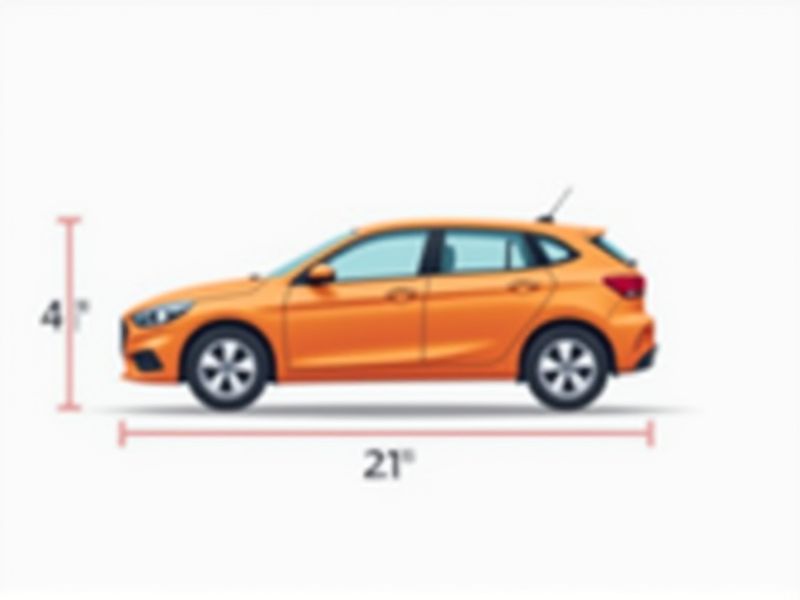
When considering a hatchback car, understanding its standard dimensions can help you determine if it fits your parking space and meets your comfort needs. Typically, a hatchback's length ranges from 3,600 to 4,200 millimeters (about 142-165 inches), making them compact and easy to maneuver in urban environments. The standard width is usually between 1,600 and 1,750 millimeters (63-69 inches), while the height averages around 1,450 to 1,550 millimeters (57-61 inches). These measurements can vary by model and manufacturer, so it's a good idea to check the specifications of the specific hatchback you're interested in.
Length
A standard hatchback car typically measures between 4,000 and 4,400 millimeters in length, catering to urban drivers who prioritize maneuverability and parking ease. Compact models, like the Volkswagen Golf or Ford Focus, often offer a length around 4,200 millimeters, striking a balance between interior space and overall size. The length not only affects the hatchback's handling but also influences cargo capacity, with most ranging from 300 to 400 liters in the boot. For your needs, selecting a hatchback within this size bracket can enhance your driving experience in both city and suburban environments.
Width
A typical hatchback car measures approximately 68 to 71 inches in width, providing a compact yet spacious design. This width allows for easy maneuverability in urban settings while ensuring passenger comfort. You can expect ample interior space, making it suitable for city commuters and small families alike. Models like the Ford Focus hatchback exemplify this standard with features tailored for efficiency and versatility.
Height
The average height of a compact hatchback car typically ranges from 58 to 60 inches, providing an optimal blend of aerodynamics and headroom. This height allows for easier entry and exit, making it user-friendly for passengers of all ages. Models like the Honda Fit and Ford Fiesta exemplify this standard, achieving heights of approximately 58.6 inches and 58.1 inches, respectively. When selecting your hatchback, consider how the height affects cargo capacity and overall driving comfort.
Wheelbase
The wheelbase of a standard hatchback car typically ranges between 2,400 mm to 2,600 mm, directly impacting ride comfort and handling. A longer wheelbase enhances stability at higher speeds and provides more interior space for passengers. Most hatchbacks balance a compact design with a wheelbase that allows for nimble maneuverability in urban environments. When choosing a hatchback, consider how the wheelbase affects both overall driving dynamics and your daily commuting needs.
Ground Clearance
The standard ground clearance for hatchback cars typically ranges from 4.7 to 6.7 inches (120 to 170 mm), allowing for a balance between comfort and functionality. This height enables better maneuverability over uneven terrain while maintaining an aerodynamic profile for improved fuel efficiency. A higher ground clearance may enhance off-road capabilities, beneficial if you often navigate rough roads. When choosing a hatchback, consider your driving conditions to ensure the ground clearance suits your needs.
Front Track
The front track measurement of a standard hatchback car typically ranges from 54 to 60 inches, which influences handling and stability during turns. A wider front track can enhance grip, allowing for improved cornering performance, as well as a more planted feel on the road. When evaluating hatchback options, consider the alignment of the front track with your driving needs; a close fit to the upper end of this spectrum often results in sportier dynamics. Brands often highlight their front track specifications, making it easier for you to compare different models effectively.
Rear Track
The rear track measurement is crucial in determining the stability and handling of hatchback cars, typically ranging from 1,450 mm to 1,600 mm for compact models. A wider rear track contributes to improved cornering performance, enhancing your driving experience by reducing body roll and increasing grip. For instance, many popular hatchbacks like the Ford Fiesta feature a rear track of 1,520 mm, which aids in delivering a balanced ride. Adhering to these standards is essential for manufacturers to meet safety and performance expectations while appealing to consumers seeking reliable and agile vehicles.
Turning Radius
The turning radius of a standard hatchback car typically ranges between 33 to 36 feet, allowing for enhanced maneuverability in urban environments. This compact design makes it easier to navigate tight parking spaces and sharp corners. For instance, models such as the Honda Fit and Ford Fiesta boast impressive turning radii of approximately 33.4 feet, which contributes to a more agile driving experience. With such specifications, hatchbacks are ideal for city dwellers who prioritize convenience and ease of handling in their daily commutes.
Cargo Space
The average cargo space in a hatchback typically ranges from 20 to 25 cubic feet with the rear seats up, providing ample room for everyday items. When the rear seats are folded down, capacity can increase significantly, often reaching up to 50 cubic feet or more, making it versatile for larger loads. You can expect models like the Honda Civic and Toyota Corolla to offer competitive features, with some variations in storage solutions like underfloor compartments or additional hooks for securing items. This flexible design is ideal for urban dwellers who need both style and practicality in their vehicle.
Seating Capacity
A standard hatchback car typically accommodates 4 to 5 passengers, making it ideal for small families or urban commuters. The rear seating area often features a 60/40 split-folding design to enhance cargo versatility, allowing up to 1,200 liters of storage space with the seats down. Average legroom for front and rear passengers can range from 39 to 41 inches, providing a comfortable experience during short or long drives. When considering your next purchase, prioritize models that offer a balance between passenger comfort and storage flexibility to meet your daily needs.
